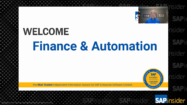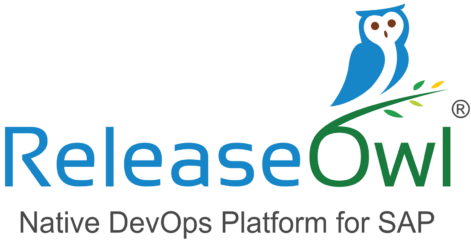SAP Cash Management
Filter By
Browse By
- SAP Analytics and AI
- SAP Application Development and Integration
- All SAP Application Development and Integration
- SAP ABAP
- SAP ABAP Development Tools
- SAP ABAP Test Cockpit
- SAP API Management
- SAP BAPI
- SAP Basis
- SAP BRF
- SAP Business Application Studio
- SAP CMS
- SAP Design Studio
- SAP Development Tools
- SAP DevOps
- SAP EAI
- SAP EDI
- SAP Extension Suite
- SAP Fiori
- SAP Fiori Elements
- SAP Integration Suite
- SAP Low Code Application Development
- SAP Low Code Automation
- SAP Netweaver
- SAP Release Management
- SAP UI5
- SAP Web Application Server
- SAP Web IDE
- SAP Business Process Management
- SAP Center of Excellence
- SAP CIO
- SAP Customer Experience
- SAP Data and Data Management
- All SAP Data and Data Management
- SAP BW
- SAP BW/4HANA
- SAP Crystal Reports
- SAP Data Archiving
- SAP Data Center
- SAP Data Governance
- SAP Data Integration
- SAP Data Migration
- SAP Data Quality
- SAP Data Services
- SAP Data Strategy
- SAP Data Visualization
- SAP Data Warehouse Cloud
- SAP DMS
- SAP Document Control
- SAP EIM
- SAP ETL
- SAP ETL Tools
- SAP HANA
- SAP HANA Administration
- SAP HANA Deployment Infrastructure
- SAP HANA Studio
- SAP Master Data
- SAP Master Data Governance
- SAP MDM
- SAP Enterprise Architect
- SAP Enterprise Asset Management
- SAP ERP
- SAP Finance
- All SAP Finance
- SAP Accounting
- SAP AR AP
- SAP Asset Accounting
- SAP Billing Systems
- SAP BPC
- SAP BRIM
- SAP Cash Management
- SAP Central Finance
- SAP Controlling
- SAP COPA
- SAP Cost Center Accounting
- SAP Currency Risk
- SAP e-invoicing
- SAP FICO
- SAP Finance Automation
- SAP Advanced Financial Closing
- SAP Financial Consolidation
- SAP Financial Planning
- SAP FX Risk
- SAP General Ledger
- SAP Global Tax Management
- SAP Hyperion
- SAP Order to Cash
- SAP Payment Processing
- SAP Profitability Analysis
- SAP Rebate Management
- SAP S/4HANA Finance
- SAP SWIFT Compliance
- SAP Treasury Management
- SAP Universal Journal
- SAP Governance Risk and Compliance
- SAP Human Capital Management
- SAP Intelligent Technologies
- SAP Platform and Technology
- All SAP Platform and Technology
- SAP Business Technology Platform
- SAP Cloud
- SAP Cloud Connector
- SAP Cloud Integration Platform
- SAP Cloud Migration
- SAP Cloud Platform
- SAP Cloud Providers
- SAP Cloud Strategy
- SAP Digital Signature
- SAP Container Platform
- SAP HANA Enterprise Cloud
- SAP Digital Asset Management
- SAP Smart Forms
- SAP HEC
- SAP Digital Integration Hub
- SAP Hyperscalers
- SAP Infrastructure
- SAP Messaging
- SAP Quality and Testing
- SAP Security
- SAP Spend Management
- SAP Supply Chain Management
- All SAP Supply Chain Management
- SAP APO
- SAP Asset Management
- SAP Business Network
- SAP Digital Manufacturing Cloud
- SAP Digital Twin
- SAP EWM
- SAP IBP
- SAP Inventory Management
- SAP Label Printing
- SAP Logistics
- SAP Manufacturing
- SAP Manufacturing Automation
- SAP MES
- SAP MII
- SAP MM
- SAP MRO
- SAP MRP
- SAP Order Management
- SAP Plant Maintenance
- SAP PLM
- SAP Production Planning
- SAP S&OP
- SAP SD
- SAP SPM
- SAP Supply Chain Planning
- SAP Track and Trace
- SAP Transportation Management
- SAP System Administration
What Is SAP Cash Management?
SAP Cash Management provides a comprehensive overview of an organization’s cash flow by processing and analyzing all cash and bank transactions. This includes payments for supplier invoices, sales receipts, stand-alone payments, and unallocated payments/receipts. SAP Cash Management also allows for analysis of financial transactions over a given period, providing vital insights into liquidity.
What Is SAP Cash Management?
SAP Cash Management provides a comprehensive overview of an organization’s cash flow by processing and analyzing all cash and bank transactions. This includes payments for supplier invoices, sales receipts, stand-alone payments, and unallocated payments/receipts. SAP Cash Management also allows for analysis of financial transactions over a given period, providing vital insights into liquidity.
For businesses looking to streamline their financial operations, SAP Cash Management provides critical functionality for managing cash flow, including analyzing financial transactions and ensuring on-time availability of funds. There are three components included in SAP Cash Management powered by SAP HANA: cash operations, liquidity management, and bank account management. These components allow organizations to streamline order-to-cash processes, improve liquidity, and enhance visibility into cash movements.
List SAP Cash Management core capabilities include:
- Managing bank account relationships
- Cash flow and liquidity reports with a comprehensive overview of your company’s financial position
- Maintaining accurate liquidity in the business
- Analyzing financial transactions for a given period
- Generating reports on cash position receipts and disbursements
- Automating payments and collections processes
Key Considerations for SAPinsiders
Consider SAP Cash Management needs as a part of a move to SAP S/4HANA. By leveraging SAP Cash Management with SAP S/4HANA, organizations can generate a complete view of cash position and liquidity, empowered by the modern technical architecture of SAP S/4HANA. The ability to track, trace, and reconcile payments in real-time provides enhanced visibility into cash movements, allowing businesses to better forecast and budget for future expenses. Finance and accounting managers can use this information to make informed decisions about cash management and ensure that adequate funds are available as needed.
Implement SAP Cash Management in SAP S/4HANA as a sidecar option to help determine a roadmap. In this interview with SAPinsider, Natasha Doerksen of Cameco talks about her company’s SAP Cash Management implementation journey.
Prioritize opportunities to lower costs and increase operational efficiency with cash management automation. The way companies are leveraging cash management, bank community, and banking communications to address issues such as lowering bank fees has become more complex. By automating cash management functionality, including payment processing and reconciling supplier statements, businesses can reduce the time and effort required to manage their finances.
479 results
-

Deploying Machine Learning to Build an Intelligent Enterprise
Reading time: 4 mins
An absence of strategy trails only domain expertise as the reason why many companies have yet to adopt artificial intelligence and machine learning. Companies are challenged with how to apply these and other breakthrough technologies for business value. This article details several examples of how organizations can deploy machine learning today, and how SAP S/4HANA…
-

Strategic Supply Chain Management, Part II of II
Reading time: 11 mins
In Part I of this two-part series, Understanding what to measure for effective KPI development, key performance indicators (KPI) were defined, the article reviewed how to develop effective KPIs for your business, and several examples of KPIs that have proven effective for the different domains in the value chain, regardless of the industry, were provided.…
-

What Brazil Nota Fiscal compliance means for SAP e-invoicing, logistics & accounting (Q&A transcript)
Reading time: 13 mins
Brazil’s Nota Fiscal eletrônica (NF-e) regulations clearly have had impact beyond technical e-invoicing processes, up and down the supply chain. As an SAP customer, what technical and strategic questions do you still have about NF-e, and what are your next steps to ensure compliance? My colleague Gary Byrne of SAPexperts recently moderated an online Discussion Forum...…
-
-

- SAP S/4HANA Finance
 Premium
Premium
Your Guide to Generating Predictable Revenue Streams with SAP S/4HANA
Reading time: 6 mins
This article will shed some light on subscription order management (SOM), which has been folded into the SAP S/4HANA digital core. You’ll learn how SOM can empower organizations to evolve their business model into one capable of selling products-as-a-service to generate new and predictable revenue streams. Membership Required You must be a member to access…
-

An Introduction to SAP Joint Venture Accounting, Part I
Reading time: 6 mins
A joint venture (JV) is an arrangement in which two or more parties come together and agree to pool their resources for a specific task. This task can be a new project or any other business activity. In a joint venture, each partner is responsible for profits, losses, and costs associated with the venture. Joint…
-

- SAP Financial Consolidation
 Premium
Premium
Accelerate Your Financial Close to Support Strategic Decision Making
Reading time: 17 mins
Establishing an efficient financial close is a challenge for many businesses due to the number of people and complexity of tasks involved, and yet it is key to a best-run finance organization. By understanding how financial transformation—including the use of automation to increase operational efficiency—can support finance teams in the close process and add more…
-

The Strategic Role of Finance In Today’s Business Landscape
Reading time: 9 mins
Finance teams have always been expected to fulfill a variety of reporting requirements to complete the financial close, also known as the record-to-report process. Today, that expectation has evolved, requiring finance professionals to deliver insights for both operational and strategic decision making. And yet completing operational tasks within the accounting and financial close process cannot…
-
-

Automation Helps Position Finance as a Strategic Partner
Reading time: 4 mins
Companies are implementing automation into their operations at a rapid pace to achieve greater business efficiencies and cost savings. Automating financial processes is a strategic area of focus in those initiatives. Learn how finance can use automation to transform from a transactional function into a strategic advisory role and decision-maker.
-

Enhance Global Tax Management with Testing Automation
Reading time: 5 mins
Indirect Tax Complexity Driving Constant Functionality Changes Real-time reporting and e-invoicing mandates drive organizations to continually update and enhance global tax management functionality to accurately assess tax obligations promptly and avoid fines or other penalties. Growing complexity in compliance management, governance, and regulations is the primary driver of an organization’s digital tax strategy, according to...…
-

- SAP Currency Risk
 Premium
Premium
Automate Your Foreign Exchange Rates
Reading time: 4 mins
Does your company conduct business in Europe, Asia, or Latin America? Gain more customers by communicating monetary amounts in their local currencies in a standard, easy, and automated way in SAP S/4HANA. For some cultures, it is important to receive amounts in their own local currencies, instead of the most common currencies. Knowing the cost…
Become a Member
Unlimited access to thousands of resources for SAP-specific expertise that can only be found here.
Become a Partner
Access exclusive SAP insights, expert marketing strategies, and high-value services including research reports, webinars, and buyers' guides, all designed to boost your campaign ROI by up to 50% within the SAP ecosystem.
Upcoming Events
Related Vendors
Your request has been successfully sent


